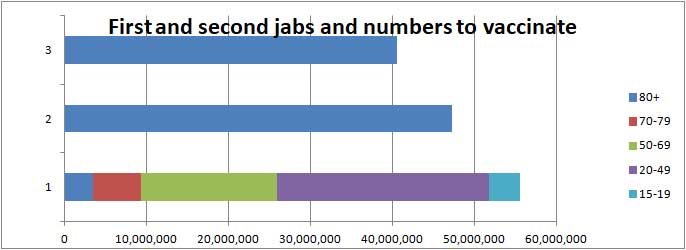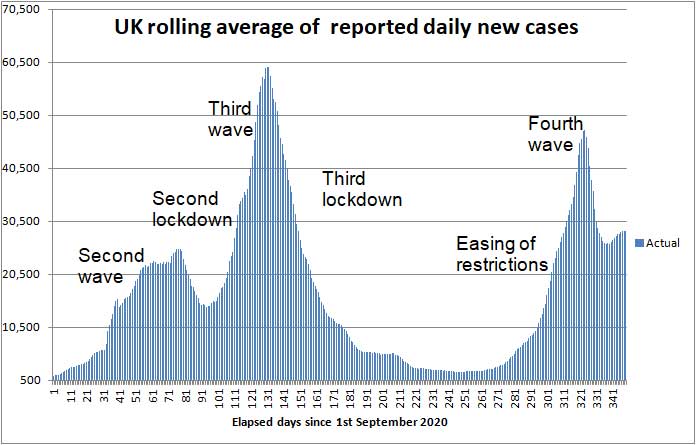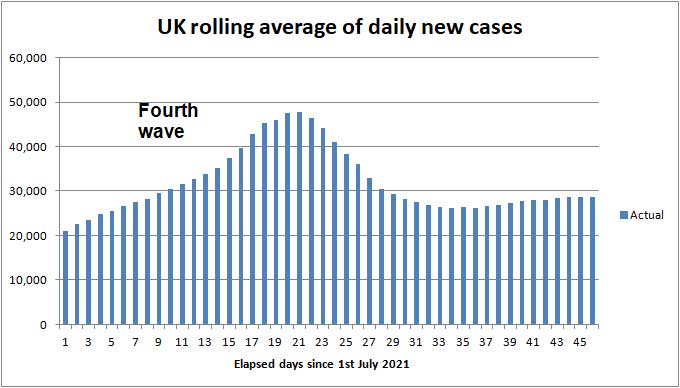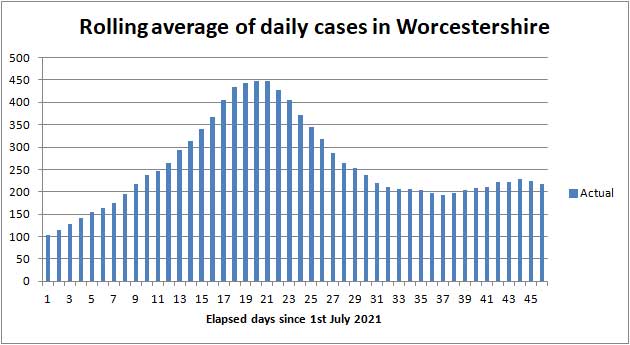
Angus and Rosemary's Miscellany
of Malvern - Other Resources
|
Coronavirus (COVID-19) epidemic weekly update for Malvern Seniors15th August 2021 DAILY CASES FLAT-LINING Take care as virus still widespread
Skip to menu of archived pages PreambleWe keep an eye on the published government figures and monitor the media to asses the level of risk for Seniors in the Malvern Hills district. This page is normally updated every Sunday between 1800 and 2400 hours GMT. Information about Coronavirus can be found on the NHS website: https://www.nhs.uk/coronavirus How to get vaccinatedThe most important thing people can do now is get vaccinated. Most Seniors should have been double jabbed by now, but if not get your vaccine, and encourage others to get theirs. During August vaccinations can be obtained at the Three Counties Show Ground without an appointment. Monday to Friday 8.00am to 5.00pm Saturday 8.00am to 1.30pm (AstraZeneca and Moderna vaccinations available) Use Brown Gate entrance, postcode WR13 6NW
|
| Districts of Worcs | Cases | Weekly increase | Population |
| Bromsgrove | 9,140 | +305 | 98,529 |
| Malvern Hills | 4,161 | +161 | 77,545 |
| Redditch | 8,221 | +251 | 85,317 |
| Worcester | 9,074 | +243 | 103,542 |
| Wychavon | 8,831 | +293 | 126,240 |
| Wyre Forest | 7,802 | +273 | 100,957 |
| TOTAL | 47,229 | +1,526 | 592,130 |
| COMPARE WITH | |||
| County of Hereford | 9,824 | +515 | 195,000 |
| Leicester (city of) | 47,439 | +1,399 | 400,000 |
Cumulative cases reported by PHE in Worcestershire to 15th August 2021
The increase is similar to last week, except for the Malvern Hills which has seen a significant rise.
Note: the weekly increase is indicative; the seven day average by area, which varies day to day, is an alternative metric that can be found on the Coronavirus dashboard.
Interactive map
At the bottom of the Coronavirus Dashboard (daily update) page there is an Interactive Map which is coloured to show the variation in infection rate across the country. This week the map shows that infection rates are low across most of Scotland and parts of Wales; still high across much of England; and very high in Northern Ireland.
Click for Interactive Map of COVID cases
Note: the Interactive Map works on desktop PCs but it's possible you may encounter difficulties using a tablet or smartphone.
Recent weekly cases to 10th August are: North Malvern 22; Malvern Link 14; Pickersleigh 6; Barnards Green 6; Malvern Wells and Priory 8; Callow End and Hanley 8; Upton and Welland 12.
Number of deaths
Statistics on COVID deaths are published by Public Health England, The Office of National Statistics, and NHS England.
PHE figures
Public Health England reports that the cumulative total of COVID (28) deaths in UK hospitals and care homes has risen by 633 in the last week to 130,953 while the daily average has flat-lined at about 90 deaths per day.
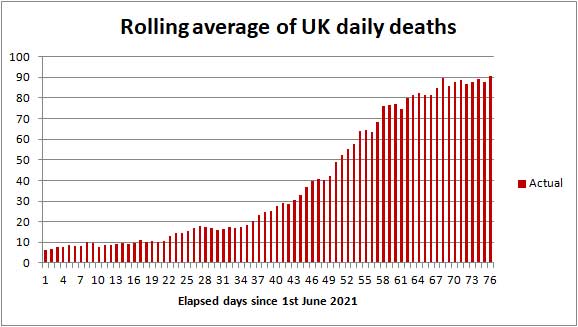
COVID-19 death rate 1st May to 15th August 2021
Click to view the UK government Coronavirus Dashboard
In comparison averaged over recent years 1,700 people die daily from all causes.
ONS figures
The Office of National Statistics (ONS) separately reports registered deaths in England and Wales where COVID-19 is mentioned on the death certificate. The ONS figures lag the PHE figures by 10 - 14 days and do not include Northern Ireland and Scotland.
Click for national ONS data on deaths (Excel spreadsheet)
The ONS figures are broken down by District providing a glimpse of where deaths are occurring. The provisional cumulative total of COVID related deaths in Worcestershire reported by the ONS up to 30th July 2021 (week 30 of 2021) is shown below.
Note: the numbers are from the ONS Death Registrations-Pivot table
| Districts of Worcs | Deaths 2020 |
Deaths 2021 |
Week 30 | Population |
| Bromsgrove | 164 | 105 | 0 | 98,529 |
| Malvern Hills | 61 | 83 | 0 | 77,545 |
| Redditch | 108 | 85 | 0 | 85,317 |
| Worcester | 87 | 117 | 0 | 103,542 |
| Wychavon | 157 | 122 | 1 | 126,240 |
| Wyre Forest | 171 | 106 | 0 | 100,957 |
| TOTAL | 748 | 618 | 1 | 592,130 |
Provisional cumulative COVID-19 deaths registered by ONS to 30th July 2021
In week 30 just one COVID related death was reported in hospital in Wychavon.
In England and Wales 402 COVID-19 related deaths were reported in the week to 30th July; 78 more than the week before, confirming the upward trend in deaths reported by PHE. Of these 38 were in a care home, 35 at home, 4 in a hospice, and 324 in hospital.
Note: summation of rows 9 to 339 of the ONS deaths Registrations-Pivot table.
The provisional UK COVID-19 death toll (as reported by PHE and ONS) for all weeks of the epidemic can be found on the Deaths tab of the Coronavirus Dashboard.
NHS England figures
The table below shows latest COVID deaths in Worcestershire hospitals reported by NHS England to 13th August 2021.
| Worcestershire | Cumulative deaths | Past week |
| Acute hospitals | 815 | 4 |
| Care hospitals | 63 | 0 |
| TOTAL | 878 | 4 |
Click for NHS COVID-19 total announced deaths
Risk of COVID-19 death by age band (updated)
NHS England provides an analysis of COVID-19 deaths in hospital in England and Wales by age band. Shown below is a breakdown of deaths for the period 1st June 2021 to 15th August 2021 over which the death rate rose to 90 deaths per day.
| Age band | Number of deaths | % of deaths |
| 0 - 19 | 7 | 0.3 |
| 20 - 39 | 67 | 3 |
| 40 - 59 | 300 | 14 |
| 60 - 79 | 862 | 42 |
| 80+ | 834 | 40 |
Risk of COVID-19 death by age band
Those aged 60+ years now account for 82% of deaths compared to 92% last year, but remember that due to vaccination the death rate as a proportion of new cases is some ten times lower than in 2020.
The infection rate in England is currently about 300 in 100,000 per week so even if this continued all year the chance of catching COVID would be no more than 1 in 7.
The probability of dying of COVID is about 1 in 500 of those that test COVID positive and as most deaths are amongst the elderly the chance of Seniors dying of COVID must be about 1 in 1,000 of those infected, and the probability of dying of COVID in any one year no more than say 1 in 10,000.
These odds are unlikely to worry fully vaccinated healthy Seniors wanting to make the most of their remaining years.
There are few COVID deaths in the Malvern Hills now thanks to the vaccination programme, but prior to this there were 144 deaths. Malvern nurse Julie Ann Omar had been one of the first victims of the Coronavirus epidemic. She sadly died self-isolating at home on the 20th April 2020 aged 52 years, after working at the Alexandra hospital in Redditch.
Healthcare numbers
The UK government Coronavirus Dashboard includes important information about healthcare statistics.
| Hospital COVID cases (UK) | Number | Change since last week |
| Patients currently in hospital | 5,875 | +244 |
| Patients on ventilation | 882 | + 11 |
| Patients admitted daily | 880 | +138 |
Headline summary of patients in hospital as reported 15th August 2021
The daily number of patients admitted to hospital has risen in the last few days. This is slightly puzzling as the number might have been expected to fall in proportion to the drop in daily cases.
One explanation could be that fewer people with COVID are now coming forward to be tested; another could be the recent peak in cases was fuelled by young people few of whom went into hospital.
From observing recent peaks it looks as though very roughly:-
-
1 in 50 of new of cases are hospitalised 8 days after testing positive.
-
1 in 500 of new cases die on average 20 days after being tested positive.
There are currently no signs of extreme pressure being put on hospitals.
Worcestershire hospital beds
Tabulated figures for bed occupancy in Worcestershire Acute and Care hospitals can be found on the NHS England website.
Click for NHS England COVID-19 Hospital bed Activity
An easy to read summary can be found on the Worcestershire Coronavirus Dashboard.
Click to view Worcestershire Coronavirus Dashboard.
There are now 39 COVID-19 patients occupying Worcestershire Acute Hospital beds, of which 4 are ventilated beds; roughly 14% of the peak experienced last January.
Between 2nd and 8th August 2021, 36 patients were admitted to hospital with coronavirus in Worcestershire implying that the average length of stay in the county could be just one week (see link below).
Click for Simple Summary of Malvern numbers on the Coronavirus dashboard
Forecast for the week ahead
Trends suggest that during the next seven days (up to 22nd August) the cumulative total of new UK COVID-19 cases reported by PHE on the Coronavirus Dashboard could increase by 200,000 towards 6,468,000.
In Worcestershire about 1,500 new cases of COVID-19 can be expected, and about 150 cases in the Malvern Hills district.
We estimate the number of COVID (28) deaths will increase by about 500 nationally towards 131,500 during the 7 days ending 22nd August 2021.
In the county of Worcestershire, assuming a 0.2% death rate, the 1,526 new cases this week should translate to no more than 3 COVID deaths per week towards the end of August.
Longer term forecast
During the last week daily cases have increased only slowly and we speculate that due to vaccination and immunity arising from past infections a tipping point has been reached where public behaviour strongly influences whether, in any week, the 7 day average of daily cases goes up or down.
The fully vaccinated elderly are likely to remain cautious so for them cases will probably go down; while many of those aged under 30, of whom a third are unvaccinated, are likely to throw caution to the winds and for those cases may go up.
In consequence daily cases could oscillate about the present level during coming weeks, but to what extent and for how long is impossible to predict.
If the PHE daily cases can be believed, the death rate should start falling slowly towards 55 deaths per day during the remainder of August tracking the recent fall from 47,000 to 27,000 new cases per day. Alternatively if the ZOE estimates are right the death rate won't fall below 80 deaths per day. These are deaths which are already 'baked-in'.
Daily cases will probably rise after students go back to schools/universities in the autumn, and then could 'surge' as more time is spent indoors during the winter with hospital admissions and deaths following in proportion. Providing UK hospital beds occupied by COVID patients don't rise above 10,000 the government is unlikely to re-impose restrictions.
Scientists say it is impossible to predict when the EXIT wave will peak and that will probably not be known for sure until two or three weeks after the peak is past. Cases are still very high and it's too early to rule out further 'bumps in the road' for example during November.
We'll just have to wait and see how things pan out during the remainder of this year and adjust our behaviour accordingly.
The scenario could change were a new variant of COVID-19 to enter the UK which escapes the present vaccines.
Advice for Seniors
 Currently
there are no more than four COVID related deaths per week in Worcestershire so we therefore judge the
risk of death for fully vaccinated
Seniors to be
LOW while the risk of Long COVID might be MODERATE;
see our annex and riskometer opposite.
Currently
there are no more than four COVID related deaths per week in Worcestershire so we therefore judge the
risk of death for fully vaccinated
Seniors to be
LOW while the risk of Long COVID might be MODERATE;
see our annex and riskometer opposite.
Remember, if you are elderly, have not been vaccinated, and were to catch COVID there is a significant chance that you will either die or your long term health may be seriously damaged, so if you are able get both doses of your vaccine and continue to take care of yourself and those you love. Also encourage others to be vaccinated.
Click for our risk of death table (for those who have not been vaccinated)
Like Sajid Javid, it is quite possible, despite a second jab, for Seniors to become ill with COVID-19; some might have mild symptoms like a common cold or hay fever, while others could feel very poorly, but few except the frail and vulnerable will need to be admitted to hospital.
Until daily cases fall markedly the simple safeguards to remember are to:
-
wash your HANDS thoroughly, using soap and hot water, for 20 seconds, including after handling deliveries to your home, to kill virus picked up from contaminated surfaces see note 1;
-
wear a FACE covering when unavoidably near other people for example when shopping, visiting hospital or the chemist, and using public transport;
-
SPACE at least 2 metres from people you don't feel safe with see note 2;
-
preferably socialise with friends and other households outdoors in the FRESH AIR, else, if you can, keep doors and windows open if you are indoors;
-
minimise TIME near strangers;
-
look out for symptoms and self-isolate and book a test if you feel unwell (the top five symptoms amongst the vaccinated in order of prevalence are now said to be headache, runny nose, sneezing, sore throat and loss of smell).
-
keep away from crowded indoor settings and areas where the infection rate is known to be high.
-
Respect others and give them space.
Notes:
1) Wash your hands thoroughly before touching your face to avoid transferring virus from contaminated surfaces to your mouth, eyes and nose. If outdoors use hand gel.
2) Two metres is further than you think - roughly an arm and a walking stick away.
Annex to 15th August update
Commentary
There is little to report this week as people are on holiday and other issues such as the situation in Afghanistan are hitting the headlines.
The media reported on Sir Andrew Pollard talking to the All-Party Parliamentary Group (APPG) on Coronavirus an informal grouping of MPs which aims to ensure that lessons are learned from the UK’s handling of the coronavirus outbreak.
The Daily Mail reported Andrew Pollard saying for example,
-
Just those with Covid symptoms should now be tested.
-
Vaccine booster jabs may not be needed this autumn because there is no evidence protection is waning.
-
Herd immunity is not a possibility with the current Delta variant because it can still infect vaccinated people.
-
A Covid variant that can escape the protection delivered by vaccines are an 'absolute inevitability'.
-
Children who aren't unwell shouldn't have to self-isolate to curb the spread of Covid.
-
Covid will become endemic in the UK (will not go away).
Click for full Daily Mail report on Andrew Pollard talking to APPG
Other weekly updates
Prof Tim Spector is on holiday so the Zoe COVID Study 13th August weekly update was given by Zoe CEO Jonathan Wolf.
A survey suggests those who are pinged by the NHS COVID app and feel unwell are quite likely to have COVID.
Click to watch Zoe COVID Study 13th August update
As usual the Independent SAGE weekly briefing covers how the numbers have been changing:-
Click to watch Independent SAGE 13th August briefing
Overseas travel (no change)
It is getting easier to travel overseas but we have given up reading UK government overseas travel advice which seems to vary day to day.
Clearly all governments are working towards facilitating travel for fully vaccinated individuals but it could be many months before things return to near normal.
For example, while fully vaccinated individuals from the US and most EU countries can now enter the UK without having to quarantine, you will have to quarantine in an expensive government hotel if you return from Mexico, and it is doubtful you will be let into Singapore or NZ.
It's possible to get an NHS Vaccination Pass for overseas travel, which requires you to prove your identity for example by providing a photo of your passport; this may facilitate return to the UK from Amber list countries.
Click for information about the NHS COVID Pass
List of vaccines
Here is the list of vaccines ordered by the UK - a shortage of vaccine had been limiting the vaccination rate in the UK earlier in the year, but possibly not now. Plenty of vaccine is on order for delivery later in 2021 some of which may be needed for booster jabs and vaccinating those aged 12 - 18 years.
| COVID-19 vaccine | Doses ordered (million) | Status |
| Pfizer BioNTech, two dose, -70 deg C | 40+60 | Approved, deliveries continuing, made in Belgium (EU). An additional 60M doses have been ordered for booster shots for the most vulnerable in the autumn. |
| Astrazeneca, two dose, fridge | 100 | Approved for those aged 30+ years; deliveries continuing. Batches made in UK, Belgium and India. |
| Moderna, two dose, -20 deg C | 7+10 | Approved. First deliveries to Wales and Scotland 7th April 2021 then England 13th April; mainly for those aged under 50 years awaiting vaccination. |
| Valneva, two dose | 60+40 | A jab from French company Valneva will be made in Livingston, West Lothian, Scotland. Delivery to start in second half of 2021. |
| Janssen, single dose | 20 | Approved, a jab from Belgian firm Janssen, owned by Johnson and Johnson; UK approval 28th May. Order reduced from 30 to 20M. |
| Novavax | 60 | A jab manufactured by US firm Novavax is being made in Stockton-on-Tees UK; phase III trials complete, awaiting approval. Should be available later this year. Glaxo Smith Kline (GSK) has been contracted to fill and package vials. |
| GSK Sanofi | 60 | Some delay due to adjusting the formula to give better protection to the elderly; expect approval end 2021. |
| Curevac | 50 | Contract placed with German company Feb 2021. Possible source of new variant vaccine later in 2021 |
Table of vaccines ordered by the UK government
Present rate of new cases and risk
The average rate of infection per 100,000 population per week in England has risen to 306 while in comparison the figure for Worcestershire is now 261 and the Malvern Hills 177.
As a yardstick we suggest a figure of below 10 can be considered LOW.
The probability of fully vaccinated Seniors catching and dying from COVID-19 is now probably less than 1 in 10,000 per year so we judge the risk LOW. A greater number may suffer from Long COVID so that risk might be assessed MODERATE. A member of the family, now recovered, had Long COVID and it was very debilitating.
The risk of death from Coronavirus for unvaccinated children and healthy teenagers is said to be small so for them the risk is LOW. There has been concern about youngsters suffering from Long COVID but a recent report by King's College London suggests this is not a major issue. To quote:
On average, the illness lasted for 5 days in younger children (5 to 11 years old) and 7 days in older children aged 12 to 17. Fewer than one in 20 (4.4%) experienced symptoms for 4 weeks or more, while only one in fifty (1.8%) had symptoms lasting more than 8 weeks. The most common symptoms reported in children were headaches, tiredness, a sore throat, and loss of smell.
Click for report - Long COVID uncommon in children, analysis finds
Nevertheless some children may be poorly for several weeks which could have a significant impact on schooling and their parent's availability for work.
About the UK COVID-19 final death toll
The UK is going to have to live with COVID-19 and a background level of infection which could increase every winter as more time is spent indoors. Barring new variants, this may result in many thousands of COVID deaths per year, as with flu. So in that respect there can be no 'final' death toll.
The present 2020/2021 death toll will likely climb from 131,000 towards 140,000 by Christmas 2021 based on the PHE definition of deaths. If ONS figures are used the UK toll could be heading towards 200,000.
Worldwide, this pandemic is not played out and it could be a further 2 to 3 years before the 'dust' finally settles and third world countries are vaccinated. The PM has promised an independent inquiry in Spring 2022 to learn lessons for the future.
At the start of the epidemic on 17th March 2020 the Chief Scientific Adviser, Sir Patrick Valance, questioned by the Health Select Committee, did not disagree with Jeremy Hunt's suggestion that a death toll of 20,000 might be a reasonable outcome.
On the other hand, Professor Neil Ferguson of Imperial College warned in some scenarios the death toll might be as high as 250,000; while we thought, in the very worst case assuming up to 1% of the UK population died the outcome might have been nearer 400,000 taking into account some build up of herd immunity.
So how well will the UK have done? When Jeremy Hunt and Sir Patrick Valance spoke there had been few deaths and they clearly underestimated what was to come. Professor Neil Ferguson was nearest the mark. A few might consider an outcome of about 140,000 deaths during 2020 and 2021 a fair result compared to a greater number of people dying in a very short space of time, more being permanently disabled by Long COVID, temporary collapse of the NHS and patients dying at home or queued in ambulances outside hospitals. You have only to look at the recent situation in India to imagine what could have happened.
Members of the Labour Party and others will no doubt say the UK has done poorly compared to the best performing countries such as New Zealand and Singapore where deaths have been much lower, not to mention the enormous expense of supporting those out of work and huge damage to the economy.
With hindsight, deaths might have been much lower if the second lockdown had been continued into December and January, but that would have meant cancelling Christmas, and who knows to what extent the public would have complied.
A member of the marketing team at US company 'My Bio Source' sent us a link to a History of Pandemics. Let's hope our brilliant scientists can continue to protect us from future threats.
Summary of Links
Symptoms
Article about the effects of Coronavirus on the human body
Reporting and how to obtain a test
How to get a test
https://www.nhs.uk/coronavirus
About joining the Zoe COVID Symptom Study:
Guidance
UK government Coronavirus guidance
Tiers
Guidance on tiers: what you need to know
Government postcode checker to find tier for other areas
Statistics
UK government Coronavirus Dashboard
Coronavirus Dashboard Interactive Map
ONS data on deaths in England and Wales (Excel spreadsheet)
NHS England COVID-19 Daily Deaths
NHS England COVID-19 Hospital Admissions
NHS England vaccination statistics
Worcestershire Coronavirus Dashboard
Worcestershire COVID-19 Vaccinations Dashboard
A glimpse of the worldwide vaccination situation can be found on the Our World in Data website.
Click for chart showing % vaccinated
Modelling
A projection of the future COVID-19 death toll and daily deaths can be found on The Institute for Health Metrics and Evaluation website.
Click for IHME projection of COVID-19 deaths
Reports
ONS Coronavirus (COVID-19) Roundup
The bigger picture
Worldometer summary of coronavirus cases worldwide
European Centre for Disease Prevention and Control info
https://www.ecdc.europa.eu/en/geographical-distribution-2019-ncov-cases
World Health Organisation info
Window on the USA
Centre for Disease Control (CDC)
American Association of Retired People (AARP)
Worcestershire
Help:
http://www.worcestershire.gov.uk/here2help
Worcestershire County Council COVID-19 information:
http://www.worcestershire.gov.uk/coronavirus
Here you will find a useful link,
'Website: Number of new cases by date in Worcestershire'
which displays interesting COVID charts and statistics for Worcestershire
Miscellaneous
Spanish Flu
Dr Jeff Kildea's commentary about the 1919 outbreak of Spanish Flu in Australia
Views of Martin McKee, Professor of European Public Health
Follow Martin McKee on Twitter
SAGE membership
Scientific Advisory Group for Emergencies (SAGE)
Scottish government:
Link to Scottish Government website
Link to Postcode checker for COVID restrictions by protection level in areas of Scotland
Welsh Government:
Guidance on COVID alert levels in Wales

The interpretations and opinions expressed are our own
Last updated 18th August 2021
 Blogs
>
Blogs
>
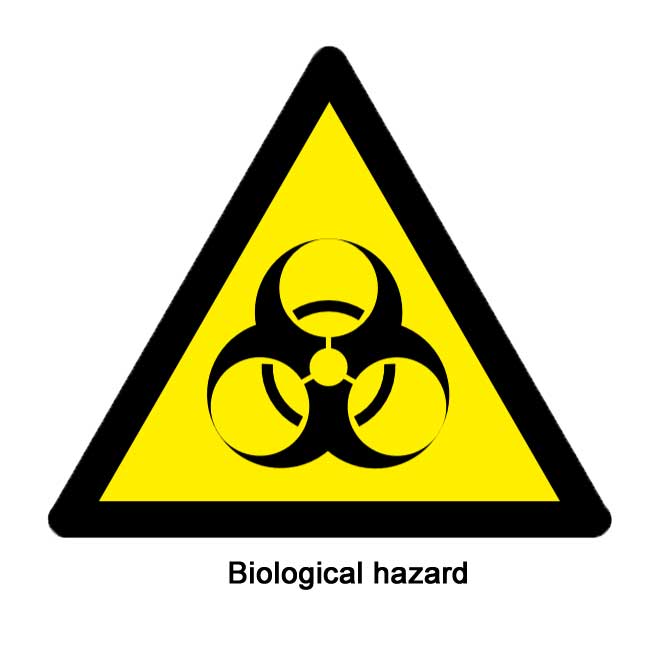 How
to request a COVID test
How
to request a COVID test You
can also collect home test kits,
packaged as the COVID-19 Self-Test (Rapid Antigen Test) in boxes of 7 tests,
from the library and most pharmacies such as Boots and Murrays in Church
Street, Claremont House and Lloyds in Barnards Green, Murrays at Prospect
View, Evans and Murrays in Malvern Link, and Boots and Morrisons on the
Enigma Retail Park. (Lateral Flow Device shown on the right).
You
can also collect home test kits,
packaged as the COVID-19 Self-Test (Rapid Antigen Test) in boxes of 7 tests,
from the library and most pharmacies such as Boots and Murrays in Church
Street, Claremont House and Lloyds in Barnards Green, Murrays at Prospect
View, Evans and Murrays in Malvern Link, and Boots and Morrisons on the
Enigma Retail Park. (Lateral Flow Device shown on the right).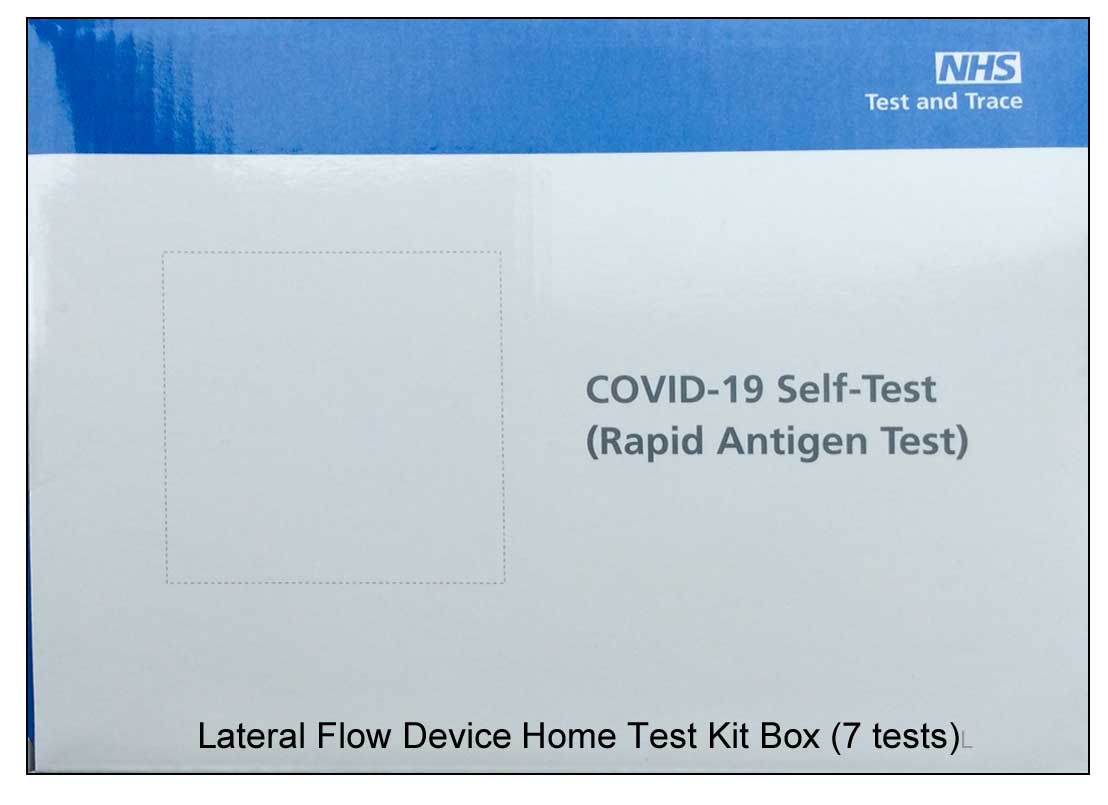
 You
can help others by downloading the COVID Symptom Study app onto your
smart phone or Ipad and reporting how you feel either daily, or as you are
able. Note there is no desktop PC version for Windows.
You
can help others by downloading the COVID Symptom Study app onto your
smart phone or Ipad and reporting how you feel either daily, or as you are
able. Note there is no desktop PC version for Windows.